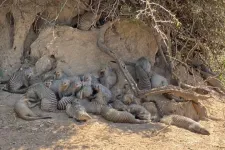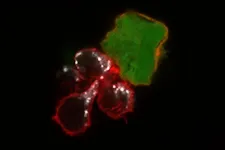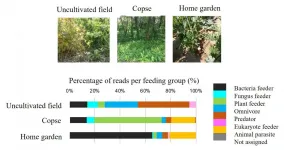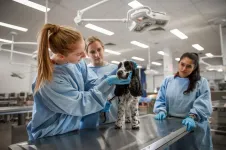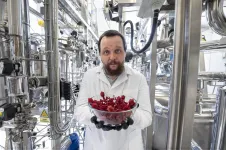RUDN University chemists create substances for supramolecules' self-assembly
2021-06-29
(Press-News.org) RUDN University chemists derived molecules that can assemble into complex structures using chlorine and bromine halogen atoms. They bind to each other as "velcro" - chlorine "sticks" to bromine, and vice versa. As a result supramolecules are assembled from individual molecules. The obtained substances will help to create supramolecules with catalytic, luminescent, conducting properties. The study is published in Mendeleev Communications.
Supramolecules are the structures made of several molecules. Individual molecules are combined, for example, by self-assembly or without external control. The resulting structure has properties that the molecules did not have individually. That is the way to create new materials, catalysts, molecular machines for drug delivery, conductors, and so on. To get a material with the specified properties, you need to choose the right starting molecules and auxiliary substances that will ensure their unification. One of the ways to control self-assembly is halogen-halogen interactions. These are the chemical bonds forming between two halogens (for example, chlorine, fluorine, bromine). RUDN University chemists have created a molecule with a halogen bond that can form supramolecules by itself or provide the required self-assembly with other substances. They will help to create substances for the chemical industry, medicine, and electronics.
"The possibility of fine control of the local molecular environment is highly desirable to access new properties for substances that function as catalysts, luminescent or conductive materials, etc. 2-4 Halogen bonding has recently emerged as useful instrument for the accurate control of the structural organization of such supramolecular materials. In this context, halogen-halogen interactions received a particular attention and were intensively explored both experimentally and theoretically", said the authors of the article.
Chemists used 7 types of hydrazones and carbon tetrachloride as starting materials for synthesis. The reaction lasted 1-3 hours at room temperature, with copper chloride as a catalyst. As a result, 7 compounds were obtained, two of them were suitable for the formation of a halogen-halogen bond between themselves or with other substances. RUDN University chemists studied them with X-ray diffraction analysis. Then the scientists built a 3D model of intramolecular interactions and confirmed their observations using topological analysis of the electron density distribution.
Thanks to the ability to form halogen-halogen bonds, new substances can control the self-assembly of molecules or form supramolecules themselves. That is because the new substances contain atoms of two halogens on two sides of the molecules -- chlorine and bromine. As a result, they can connect to each other through halogens -- chlorine combines with bromine, and vice versa. They can also form halogen-halogen bonds with other substances, thus controlling the assembly of supramolecules.
"Calculations demonstrated that highly polarizable dichlorodiazadiene unit is capable of acting as a relatively strong halogen bond donor. When the dye was decorated with halogen bond-accepting bromine atoms, formation of 3D supramolecular framework was observed", said the authors of the article.
INFORMATION:
[Attachments] See images for this press release:
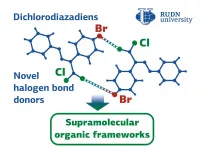
ELSE PRESS RELEASES FROM THIS DATE:
2021-06-29
For the first time, scientists detected gravitational waves caused by mergers between black holes and neutron stars. Researchers from LIGO, Virgo, and KAGRA detected the two gravitational wave events--from distances of more than 900 million light-years away--within a span of 10 days in January 2020 during the second half of LIGO and Virgo's third observing run. Astrophysical Journal Letters published the results and their implications today: https://iopscience.iop.org/article/10.3847/2041-8213/ac082e.
Researchers from Rochester Institute of Technology's Center ...
2021-06-29
The LSL60101 compound, a specific ligand of the I2-IR receptors in the brain, could shed light on the development of future strategies against Alzheimer's disease. This is stated in the recent studies by the Research Group on Medicinal Chemistry and Pharmacology of Neurodegenerative Diseases of the University of Barcelona, published in the journals European Journal of Medicinal Chemistry and British Journal Pharmacology. In studies carried out with mice, LSL60101 has improved the cognitive deficit and the biomarkers related to the disease in these animal models.
These studies result from the collaboration of the research teams led by professors Carmen Escolano, from the Faculty of Pharmacy and Food Sciences and the Institute of Biomedicine of the UB ...
2021-06-29
Preschool children are sensitive to the gap between how much they know and how much there is to learn, according to a Rutgers University-New Brunswick study.
The research, published in the journal END ...
2021-06-29
Under a concrete drainage culvert at the edge of a town in Botswana, a troop of banded mongoose is getting ready to leave its den. Moving from shade into light, the cat-sized animals scan the area for signs of danger and for opportunities to find something to eat in an increasingly crowded neighborhood.
Unbeknownst to them, the genetics of this troop's members -- and others like them -- are providing researchers in the College of Natural Resources and Environment with new understandings of how and why animal behavior changes in proximity to human development and how that change can impact infectious disease spread.
The researchers used genetic tools to identify changes in movement behavior among mongooses ...
2021-06-29
An immunotherapy based on supercharging the immune system's natural killer cells has been effective in treating patients with recurrent leukemia and other difficult to treat blood cancers. Now, researchers at Washington University School of Medicine in St. Louis have shown in preclinical studies conducted in mice and human cells that this type of cell-based immunotherapy also could be effective against solid tumors, starting with melanoma, a type of skin cancer that can be deadly if not caught early.
The study is published June 29 in Clinical Cancer Research, ...
2021-06-29
[BRIDGEWATER, NJ; June 29, 2021] The American Association of Feline Practitioners (AAFP) has released the updated 2021 AAFP Feline Senior Care Guidelines to be published in the July issue of the Journal of Feline Medicine and Surgery. This update provides emerging advances in feline medicine with respect to the aging cat. The Task Force of experts provides a thorough current review in feline medicine that emphasizes the individual senior patient.
As defined in the 2021 AAHA/AAFP Feline Life Stage Guidelines, cats over 10 years of age are considered to be 'senior.' Understanding the changing needs of each individual senior cat is critical for both veterinary professionals and cat owners. "Veterinary professionals are encouraged to use the 2021 ...
2021-06-29
Osaka, Japan - A team of scientists led by the Department of Applied Physics at Osaka University, the Department of Physics and Electronics at Osaka Prefecture University, and the Department of Materials Chemistry at Nagoya University used photoinduced force microscopy to map out the forces acting on quantum dots in three dimensions. By eliminating sources of noise, the team was able to achieve subnanometer precision for the first time ever, which may lead to new advances in photocatalysts and optical tweezers.
Force fields are not the invisible barriers of science fiction but are a set of vectors indicating the magnitude and direction of forces acting in a region ...
2021-06-29
Overview
The research team of Professor Toshihiko Eki of the Department of Applied Chemistry and Life Science (and Research Center for Agrotechnology and Biotechnology), Toyohashi University of Technology used a next-generation sequencer to develop a highly efficient method to analyze soil nematodes by using the 18S ribosomal RNA gene regions as DNA barcodes. They successfully used this method to reveal characteristics of nematode communities that inhabit fields, copses, and home gardens. In the future, the target will be expanded to cover all soil-dwelling organisms in agricultural soils, etc., to allow investigations into a soil's environment and bio-diversity. This is expected to contribute to advanced agriculture.
Details
Similar to when the ...
2021-06-29
Receiving a simple thank you, spending time with peers and further developing their expertise, are all factors that make veterinarians feel good at work, according to a new study by researchers at the University of Adelaide.
In the study published by Vet Record, researchers investigated the positive side of veterinary work and specifically what brings vets pleasure in their job.
Lead author Madeleine Clise, a psychologist and Adjunct Lecturer at the University of Adelaide's School of Psychology says: "At a time in Australia when there are national shortages of vets, particularly in regional areas, and increased publicity about the ...
2021-06-29
Prolonged exposure to antibiotics leads to the gain of bacteria's ability to defeat the drugs designed to fight them. Thus, if such antibiotic-resistant bacteria cause the infection, the only chance to use a specialized virus called phage infecting specific bacteria species. It is a powerful weapon against deadly diseases. At the same time, the effective treatment depends on factors that would not be suspected for years to impact the successful therapy. Recently, researchers from the Institute of Physical Chemistry, Polish Academy of Sciences led by dr. Jan Paczesny and Professor ...
LAST 30 PRESS RELEASES:
[Press-News.org] RUDN University chemists create substances for supramolecules' self-assembly


